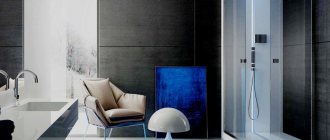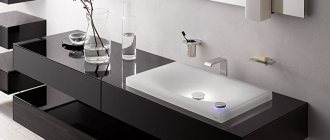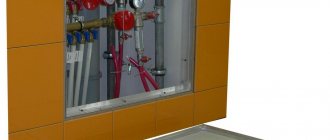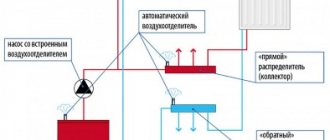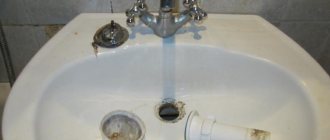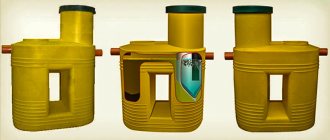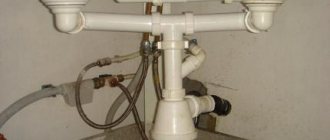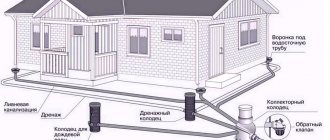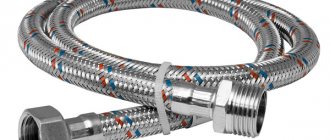Modern heated towel rails sometimes look like objects of avant-garde art. Their whimsical shapes involuntarily attract the eye, making a utilitarian item an exquisite accessory. But there is no and probably will not be a dryer more reliable, simpler and more versatile than the “snake”, well known from childhood. If you plan to replace or install a heated towel rail, you should choose a regular coil made from domestically produced seamless pipes for the bathroom. This design perfectly withstands pressure in the system; its installation does not require re-equipment of the wiring. And modern models made of shiny or enamel pipes can be quite attractive.
What rules and regulations require installing a heated towel rail?
What are heated towel rails for? Is it really not possible to dry towels by hanging them on the loggia, in the bathroom or in the kitchen?
Everything is very simple. The heated towel rail provides additional heating of the air in the bathroom, bringing the temperature to a comfortable level. This is especially true when we get out of the bathroom wet.
The temperature that does not allow you to feel discomfort at this moment was determined experimentally and is prescribed in SanPiN 2.1.2.2645-10, paragraph 4.1. which reads as follows: “Heating and ventilation systems must ensure acceptable microclimate and indoor air conditions. The optimal and permissible microclimate parameters in the premises of residential buildings are given in Appendix 2 to these sanitary rules.”
Below is a table from the specified Appendix 2:
As you can see, the acceptable temperature in the bathroom is from 17 to 26 degrees. There is almost always 17 degrees in a living room and in this case there is no need to install a heated towel rail. But it is quite difficult to ensure an optimal temperature of 23°C without additional heating in a bathroom where there are no heating radiators.
Heated towel rail against mold and mildew
As you can see, one of the functions of a heated towel rail is to maintain a temperature that is comfortable for taking a bath or shower. But it also has one more important function, much more important, but not prescribed in SanPiNs and SNiPs. This is to ensure stable ventilation and reduce humidity in the bathroom.
The bathroom differs from all other rooms in the house by its specific microclimate. This is where we take a shower, enjoy a hot bath, perform daily hygiene procedures and wash clothes. Water vapor accumulating in the bathroom air creates high humidity, which can be fatal not only for the building materials used in finishing, but also for our health.
Under the influence of humidity in the absence of reliable ventilation in the corners, behind false ceilings, under baseboards and behind false walls made of plasterboard, mold and mildew may soon appear, which not only spoil the appearance of the room, but also destroy building materials in the process of their vital activity - the plaster cracks and crumbles, cracks appear, the air is filled with a heavy smell of mold, and fungal spores that multiply in the warm, humid air of the bathroom can become a health hazard, causing lung diseases.
It would seem - what does a heated towel rail have to do with it? And the heated towel rail is here because it allows you to quickly dry the air in the room, preventing the appearance of fungus and mold.
In addition, warmer air with a lower density rushes into the exhaust openings of the ventilation system, providing reliable draft and allowing moist air to be quickly removed from the bathroom.
Functions of a heated towel rail in the bathroom
1. Drying towels and linen
Obviously, one of the main purposes of a heated towel rail is to dry towels. This is a convenient additional detail, on which it is convenient to hang small items - underwear, towels, socks, rags, for which there is not enough space on a regular battery.
2. Bathroom heating
Even such a small device as a coil can save you in the cool season, when cold and dampness reign throughout the entire apartment, including the bathroom. A dryer adds warmth to a room and helps things dry faster.
For water heated towel rails operating from a hot water supply and heating system, there is one problem - idle time during periods of water outage. If you prefer to control the operation of the dryer yourself, purchase an electric product. Like water ones, they will do an excellent job of heating. For spacious bathrooms, it is better to choose a large heated towel rail - usually these are electric heated towel rails - ladders, which, in addition to their large size, are also distinguished by a larger number of rungs than coils.
3. Removing excess moisture
High humidity is a standard problem in the bathroom, which is difficult to cope with with ventilation alone. When humidity is high, mold and mildew appear on walls, ceilings, and in the joints between tiles. In such situations, you cannot do without a heated towel rail.
As an additional means of heating, you can also use a heated floor, which will not only heat the bathroom, but also create pleasant warmth under your feet, as well as quickly dry the surface.
Installation of the coil
Installing a coil is a rather complicated, but interesting task. Almost everyone can cope with this task. The most important thing is to follow the instructions. Many people invite plumbing specialists to carry out such work. In fact, you don't have to do this. A coil is essentially a pipe that has a curved shape, so installation is practically no different from installing a regular pipe.
Before you purchase and install a unit, you need to make some very important calculations. It is worth calculating the following criteria:
The operating pressure for the coil should not be lower than the pressure in the hot water supply system itself
If pressure surges occur in the system, then care must be taken to find out what maximum pressure the purchased unit can withstand. It is worth paying attention to the calculation of the standard thermal power according to the documentation attached to the coil. Now, after the choice has been made and the calculations have been made, you can begin to install the coil
Installation features for water and electric units are slightly different. Various nuances must be taken into account
Now, after the choice has been made and the calculations have been made, you can begin to install the coil. Installation features for water and electric units are slightly different. Various nuances must be taken into account.
If we are talking about purchasing a water coil, then you must initially consult with a plumber who can give recommendations on the technical connection capabilities and features of a particular heating system. Only after this can you choose a specific model that will fit perfectly into the bathroom.
coil installation
During installation, it is necessary to take into account that the elements to be connected can be made of different materials. For example, the pipes are steel, but the coil itself is copper. In this case, it is necessary to install a special dielectric gasket. It will be able to prevent the appearance of stray currents that arise at the junction of two different materials with different types of conductivity.
If we are talking about installing an electric coil, then you should also pay attention to some nuances. Of course, the electric unit is very easy to install, but it’s still worth listening to the advice of professionals so that no unforeseen situations arise
By the way, photos of a coil in a bathroom will help you clearly see what a particular model looks like after installation
Visual perception is always very important no matter which model is chosen for installation
So, when installing an electric coil, the following nuances must be taken into account:
- It is worth drawing up a competent project together with a competent electrician, because there is high air humidity in the bathroom, and this can lead to electric shock.
- All sockets located in the bathroom must be securely mounted into the wall. This will prevent contact between the wires and liquid, which is abundant in this room.
- The best socket option is a splash-proof model that has a special cover.
- It is necessary to install a special protective device that prevents the supply of electricity to the outlet in the event of a short circuit.
- The connection is made using a thick, double-insulated cable.
Thus, installing one or another type of coil is a rather complex task that requires compliance with many nuances. If you follow all of them, the installation will be done correctly. When working, it is still better to contact plumbers so that they can competently help you choose the right unit and make the appropriate calculations. In the case of an electric coil, the situation is a little more complicated. Here, in addition to a plumbing specialist, you will need the help of an electrician. All the main work is done with your own hands, so installing a coil is not such an expensive task.
Types of heated towel rails
When choosing drying equipment, most consumers pay all attention to its shape and design. In principle, this is correct, because a heated towel rail in a bathroom immediately attracts attention, so it should look harmonious in the interior of the room.
You definitely need to pay attention to the heating method.
All heated towel rails are divided into three types, which have different characteristics. Before making a purchase, you should understand all the nuances.
Water appliances
This type of equipment is practical and affordable, which is why it is in great demand. The device starts working after connecting to the hot water supply.
Water appliances are operated continuously as long as there is hot water in the pipes.
During operation, scale will accumulate inside the pipes, problems with valves and dampers are possible, so the product must be of high quality. The average lifespan of water heated towel rails is 30 years.
Electrical devices
Externally, the electric model of the device is similar to the water model, but it produces less heat. An electric heated towel rail does not require hot water.
Its installation requires the installation of a special outlet in the room, which must be protected from moisture.
The device runs on electricity, which means that electricity consumption will increase.
The surface of the equipment heats up evenly and quickly, due to the fact that inside the pipes there is not water, but vegetable and mineral oil or other solutions with high thermal conductivity.
Some products have a water heating cable inside the pipes.
Combined options
A combined heated towel rail is essentially a water model with electric internals. The device is made from thin-walled pipes and connected to hot water supply using an intermediate heat exchanger.
Such devices are characterized by increased durability, safety and uniform heating of the room.
Electrical devices
Electric models are a good alternative to classic water-based coils.
The main advantage of this type of dryer is its autonomy, because the user can turn it on at any convenient time. The operation of the device is based on a heating element, oil or water, which is heated by electricity. And if water devices are installed only near a direct connection with the heating system, then electric ones are not tied to this factor and can be placed anywhere, provided that there is an outlet there. As for energy consumption, according to experts, it remains virtually unchanged. The monthly operation of the coil is comparable to the operation of a conventional 100 W light bulb.
However, when purchasing an electrical device, you need to take into account its power consumption and the presence of a regulator that controls the ambient temperature. In terms of safety, there are no comments regarding the electrical device. It is reliably protected from contact with water and is safe for use in wet environments.
Operating principles of the heating system
This connection option does not pose any technical difficulties. A heated towel rail is a heating device installed in almost every city apartment. From a constructive point of view, this is an external element of communications through which hot coolant or hot water of the DHW system circulates. Such elements are often installed as a compensating loop of the heating system, playing the role of an additional source of heat in rooms with high humidity. The name of the element speaks for itself, hence the serpentine shape, thanks to which you can effectively use the heated circuit.
For aesthetics, heated towel rails are usually made of stainless steel or plated with nickel. The design itself and the method of connecting the heated towel rail to the centralized communication make it possible to connect a water floor pipe to it without much difficulty. As a rule, small diameter pipes are used for heated floors. For a bathroom, the area of which rarely exceeds 4-5 m2 in a city apartment, only 15-20 meters of pipe will be required.
There are two types of heated towel rails:
- a coil that is connected to a centralized heating system;
- a coil that is connected to a centralized hot water supply.
In the first case, with the onset of the heating season, water fills the heated towel rail and accordingly enters the heated floor circuit, heating the floor surface.
The first option only works during the heating season. The rest of the time your heated floor will be inactive. A coil connected to the DHW system looks preferable. Such a floor in the bathroom will always work, providing a good microclimate and comfortable temperature.
Why domestic heated towel rails are more reliable than imported ones
Imported equipment is most often designed to be connected to a heating system. In addition to being inconvenient, the quality of water in our heating networks leaves much to be desired, so pipes and dryer seals fail very quickly.
Another detail is that the thread diameter in domestic devices almost always coincides with the connecting nodes on the pipeline. On imported coils these parameters may not be the same. But this is not the most important thing.
The pressure in the hot water system depends on the condition of the pipeline, the initial pressure in the boiler room and even the number of floors. According to standards, the pressure at the entrance to plumbing equipment should not exceed 4.5 atmospheres, but in practice this value can be much higher, especially on the lower floors.
The design pressure for coils is 6 atm. in operating mode and 10 atm. during overloads. In practice, it is advisable to choose values an order of magnitude higher; this will provide some guarantee against a gust during a strong pressure surge.
Important! Domestic heated towel rails are designed for large pressure surges. Imported structures may not withstand peak overloads.
Heated floor design instead of a heated towel rail
High-quality work directly depends on a properly installed substrate. It consists of 5 main components:
- insulation from possible leaks;
- metal mounting mesh;
- thermal insulation;
- damper tape compensating for various expansions;
- one type of screed (dry or wet).
On average, the thickness of such a substrate is 5–15 cm.
The essence of the design is that metal-plastic pipes are fixed together into fragments, placed on a substrate and fixed to the collectors. The coolant circulates through the latter, and the return is returned. Warm floors are a low-temperature design, because their heating does not exceed 45 °C.
Reference! For improved heating of the room, it is better to use ceramic tiles or concrete screed as a floor covering.
Advantages
- No interference with finishing the room;
- preservation and saving of heat consumption. This is especially true for rooms with high ceilings;
- Absolutely environmentally friendly. This design does not have a negative impact on human health.
Flaws
- Expensive installation of heated floors;
- administrative ban on installation of this structure;
- increase in floor weight due to layering of the substrate in the bathroom.
Material of manufacture
The operating principle of the above types of coils is almost the same. The only differences are the heating method or the material used.
Modern manufacturers use the following materials:
- Stainless steel. It is considered the most practical, but is afraid of interaction with aggressive impurities in water. Stainless steel coils are often coated with chrome, polish or waterproof paint. The most durable and reliable are chrome-plated models. Painted products are also in great demand, but their service life is much lower than the previous ones, and the paint wears off quickly.
- Black steel with protective coating. The inner walls of this material are treated with an anti-corrosion compound. From the outside, the device is not much different from stainless steel models.
- Non-ferrous metals. In most cases, brass and copper are used here, which have good heat transfer but a short service life. Such devices are famous for their aesthetic appeal, but not for their practicality.
When purchasing a stainless steel coil, you need to make sure that it is really high-quality material. The fact is that recently a lot of fakes have appeared on the market that look exactly like good stainless steel, but are actually just a marketing ploy. To avoid a rash choice, you must ask the store for documents and a guarantee.
Manufacturers of heated towel rails
There are a great many manufacturers of radiators, both foreign and domestic. English, Belgian, German and Italian radiators are considered the recognized leaders in the heated towel rail market.
Of course, these are quite high quality models, but their prices are too high. Then you should pay attention to domestic brands of heated towel rails:
- "Nika" is a St. Petersburg company that uses imported components for the production of radiators;
- "Sunerzha" is a company that produces stainless steel heated towel rails; large assortment and quite good quality;
- AquaStal produces both economy and premium models.
These are the most famous companies here in Russia. Which heated towel rail is best is up to you to decide.
Connecting a water heated towel rail to hot water supply or central heating
Heated towel rails can be connected to a hot water supply (DHW) or heating system. The first option allows you to dry bath accessories throughout the year, because... hot water is not turned off during the warm season. The dryer pipes heat up only when the coolant is consumed, so the device cools down completely overnight.
When connected to the heating network, you can use the heated towel rail only in the cold season. However, due to the forced circulation of hot water, it will remain warm around the clock.
Copper and brass heaters must be marked as galvanized and suitable for water supply risers.
Installation in a riser
The dryer is inserted in the following sequence:
- Preparation of materials and tools. To install a water heater you will need an adjustable wrench, a grinder, dies for threading, a low-speed drill, telescopic brackets, dowels and screws, American type taps, a Mayevsky tap (for air release), straight and corner fittings (depending on the type connections), sealant and sealant for joints. The system itself is assembled from a heated towel rail, a bypass jumper and several pipes, the length of which is selected depending on the layout and location of the device.
- Dismantling of old equipment. Work to remove the old device and/or install a new one will require permission from the management company (MC). Its employee closes the common hot water or heating riser for a regulated time. If there is an old dryer, it is removed from the threaded connections or cut off, and then removed from the mounts (brackets). If you are just planning to install the device, then a gap is cut out in the riser, which is slightly larger than the width of the heater.
- Preparation of bends and lintels, laying tiles. Ball valves are installed on the branches after the bypass. You can fix the system before finishing the room, but in this case the thickness of the glue and tiles is added to the distance to the wall.
- Marking for fastenings. It is carried out taking into account the slope of the branches, the horizontal position of the heater and the distance between its parts. After checking the markings, you can drill holes, screw in dowels and install brackets.
It is recommended to install a towel dryer during a major renovation of an apartment or when replacing a water riser. This will allow you to choose more reliable material options and a convenient connection diagram.
Self-installation of a simple configuration
Installation of the coil is carried out after completion of the preparatory work. Branch pipes, angles and fittings are connected to the finished bends. Each connection is sealed with fum tape or silicone gasket.
Installation of the heated towel rail is carried out simultaneously on the bends and installed brackets. The device is secured with screws.
Upon completion of work, the system is tested for functionality and tightness. The DHW or heating riser is temporarily opened, filling the heater with water. If the connection is made correctly, it circulates freely in the system, the joints do not get wet, and the metal surface remains hot.
Before installing the system yourself, you should watch training videos with instructions for installing the dryer (step by step and with all fittings).
Technology for working with the “Ladder” model
For heated towel rails of the “ladder” type, predominantly lateral and diagonal installation schemes are used. For bottom connections, you can install rotating angles and additional pipes on the bends, which will allow pipes to be brought in from the side.
The installation sequence of the device is the same as for the coil. The shape of the heater is taken into account only when choosing the layout and marking of the mounting. The brackets are installed at 2 points at the level of the middle of the “ladder”.
Connection to a centralized heating system
Tapping into the heating system can only be done outside the cold season. To do this, you will have to obtain permission from the management company, shut off the riser and drain the cold water.
To prepare the bends, it is better to invite a specialist from the management company. Having a document with a list of work performed will allow you to relieve yourself of responsibility in the event of an accident. The risk of leaks on the heated towel rail itself is minimized by shut-off taps after the bypass.
A significant disadvantage of tapping into the heating system is a delayed leak test.
Water models
The most popular types of coils are water appliances. They represent a kind of “classics of the genre”, which were used in the distant past. Every old house is equipped with such a device.
The device is connected to the central system and can only work in cold weather, when the heating season begins. Hot water circulates inside the structure, which warms up the room.
But with an autonomous heating system, the water device will function all year round. Any changes or shutdowns are impossible, since the owner of the premises himself determines when to turn on the heating and when to turn it off.
The disadvantage of a water heated towel rail is the risk of air pockets or sediment on the walls. Fortunately, troubles can be solved by simply cleaning the pipes.
If the water quality is too low, it will not be possible to avoid scale formation inside the mechanism. This phenomenon can cause damage to the coil.
Connecting a heated towel rail in a country house
Installing a heater in a private home has a number of advantages:
- permission from the Criminal Code and notification of neighbors are not required;
- the dimensions of the device are not limited to standard bathroom sizes in apartment buildings;
- if you have your own clean well, the pipes are not clogged with sediment and dirt, you can purchase an imported system that is demanding on the quality of the coolant;
- the owner can install shut-off valves at any point, because stopping water circulation does not affect its availability and temperature for other DHW users.
In country houses, the device is installed according to the same algorithm as in an apartment.
Installation method
Depending on the mounting method, devices are divided into:
- wall,
- floor
Wall-mounted ones save space and fit well into the interior.
Floor-standing ones are large-sized samples. An unsuitable option for the bathroom of a typical apartment building. Before installing such equipment, you will have to re-equip the sewer system with replacement of water supply pipes.
Both wall and floor mounted ones can be equipped with a rotating mechanism. The essence of an interesting engineering solution is the ability to rotate part or the entire structure of heated towel rails.
Energy efficient heated towel rails
A rational approach to the selection of home appliances and electric heating devices used in the house implies the use of energy-efficient ones. Taking this point into account, new models are equipped with operating mode switches and timers.
However, it is most beneficial to keep the heated towel rail on all the time - maintaining the set temperature will require less energy than periodically heating a completely cooled device.
As for timers, their presence allows for more comfortable operation of the device - you can set the turn-on time in advance, calculating how much time it will take to heat the towels and the room itself.
No less convenient are models equipped with a thermostat - users are given the opportunity to program the device to obtain a certain, comfortable temperature.
Dimensions
- Center distance. A parameter that determines the correspondence of the basic points of drainage to the distance between the axes of the coil. The more sections for towels, the lower the digital values. There are 20 step size options ranging from 5 to 48 cm.
- Pipe diameter. In new buildings, devices with a diameter of 32 mm are installed. Products of 25 mm are less common. In older houses you can see 40 mm dryers. When deciding which dryer to choose, you first need to find out the diameter of the pipes in the bathroom.
- Width height depth. Dimensional values of this category are calculated along the outer contour.
Minimum and maximum values:
- height 3-190 cm,
- width 3-100 cm,
- depth 2-70 cm.
- The number of sections in the bathroom coil. In the retail chain, the range of models by number of sections ranges from one to twenty crossbar dryers. A small number of sections does not mean that the bathroom does not receive enough heat. The quality of heating is influenced by another indicator - the power of the selected device.
